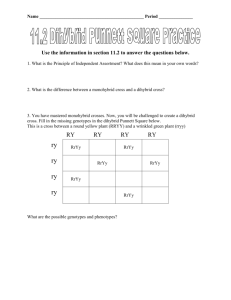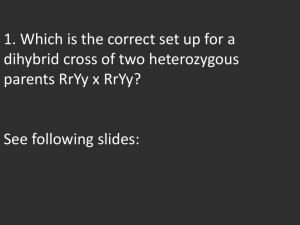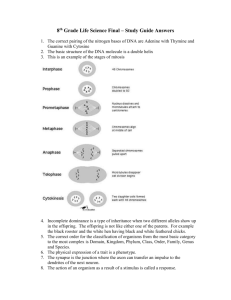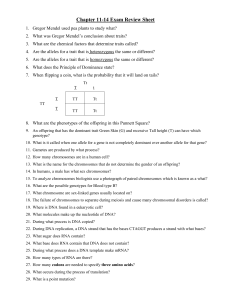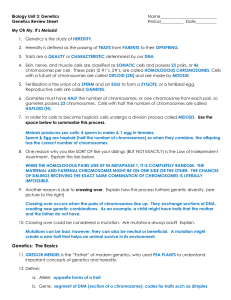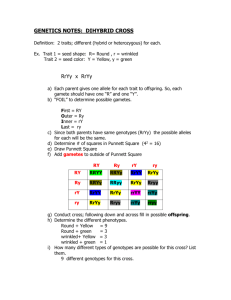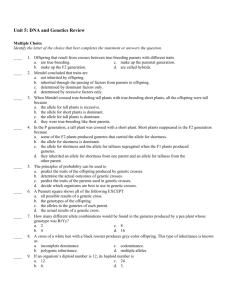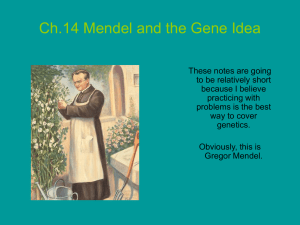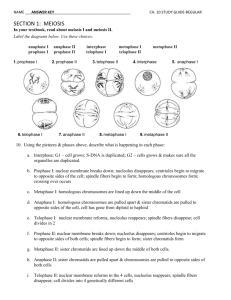Incomplete Dominance
advertisement
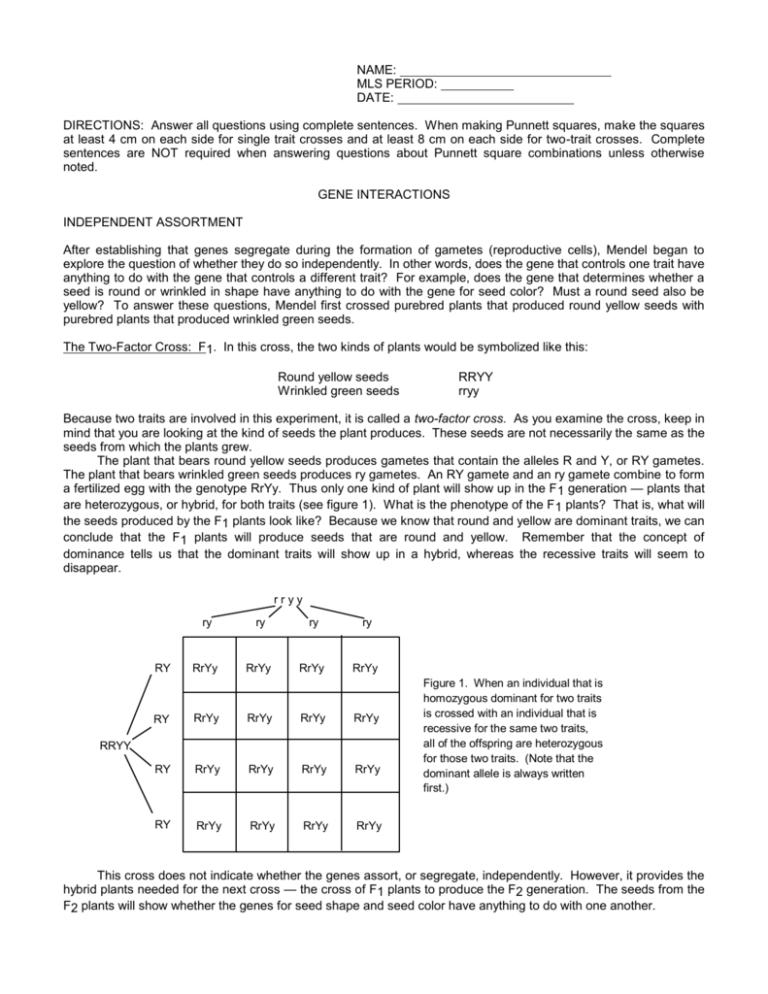
NAME: MLS PERIOD: DATE: DIRECTIONS: Answer all questions using complete sentences. When making Punnett squares, make the squares at least 4 cm on each side for single trait crosses and at least 8 cm on each side for two-trait crosses. Complete sentences are NOT required when answering questions about Punnett square combinations unless otherwise noted. GENE INTERACTIONS INDEPENDENT ASSORTMENT After establishing that genes segregate during the formation of gametes (reproductive cells), Mendel began to explore the question of whether they do so independently. In other words, does the gene that controls one trait have anything to do with the gene that controls a different trait? For example, does the gene that determines whether a seed is round or wrinkled in shape have anything to do with the gene for seed color? Must a round seed also be yellow? To answer these questions, Mendel first crossed purebred plants that produced round yellow seeds with purebred plants that produced wrinkled green seeds. The Two-Factor Cross: F1. In this cross, the two kinds of plants would be symbolized like this: Round yellow seeds Wrinkled green seeds RRYY rryy Because two traits are involved in this experiment, it is called a two-factor cross. As you examine the cross, keep in mind that you are looking at the kind of seeds the plant produces. These seeds are not necessarily the same as the seeds from which the plants grew. The plant that bears round yellow seeds produces gametes that contain the alleles R and Y, or RY gametes. The plant that bears wrinkled green seeds produces ry gametes. An RY gamete and an ry gamete combine to form a fertilized egg with the genotype RrYy. Thus only one kind of plant will show up in the F 1 generation — plants that are heterozygous, or hybrid, for both traits (see figure 1). What is the phenotype of the F 1 plants? That is, what will the seeds produced by the F1 plants look like? Because we know that round and yellow are dominant traits, we can conclude that the F1 plants will produce seeds that are round and yellow. Remember that the concept of dominance tells us that the dominant traits will show up in a hybrid, whereas the recessive traits will seem to disappear. rryy RY ry ry ry ry RrYy RrYy RrYy RrYy RY RrYy RrYy RrYy RrYy RY RrYy RrYy RrYy RrYy RY RrYy RrYy RrYy RrYy RRYY Figure 1. When an individual that is homozygous dominant for two traits is crossed with an individual that is recessive for the same two traits, all of the offspring are heterozygous for those two traits. (Note that the dominant allele is always written first.) This cross does not indicate whether the genes assort, or segregate, independently. However, it provides the hybrid plants needed for the next cross — the cross of F1 plants to produce the F2 generation. The seeds from the F2 plants will show whether the genes for seed shape and seed color have anything to do with one another. The Two-Factor Cross: F2. What will happen when F1 plants are crossed with each other? If the genes for seed shape and color are connected in some way, then the dominant R and Y alleles (which came from one parent) and the recessive r and y alleles (which came from the other parent) will be segregated as matched sets into the gametes. Thus, the gametes could only contain one of two possible gene combinations: RY or ry, as seen in figure 2. RrYy RY ry RY RRYY RrYy ry RrYy Figure 2. If the genes f or two traits are connected in some way , only two combinations of the traits are possible in the of f spring. RrYy rryy If the genes are not connected, then they should segregate independently, or undergo independent assortment. This produces four possible types of gametes: RY, Ry, rY and ry. In addition, if the genes assort independently, some of the seeds produced by the F2 plants will have new combinations of traits — they may be wrinkled and yellow or round and green. This two-factor cross is examined in figure 3. Now that we have four possible gamete types (and sixteen possible offspring types) the square is especially useful. If the genes for seed shape and seed color are inherited independently, then the seeds produced by the offspring should be in the same proportions as that predicted by the Punnett square. RrYy RY Ry RY Ry rY ry RRYY RRYy RrYY RrYy RRYy RRyy RrYy Rryy RrYy F generation 2 rY RrYY RrYy rrYY ry RrYy Rryy rrYy rrYy Figure 3. If the genes f or two traits are not linked, then they will undergo independent assortment. This results in new combinations of the traits. rryy Mendel actually carried out this exact experiment, and his results were very close to the ratio predicted by the Punnett square in figure 3. From these results Mendel concluded that genes could segregate independently during the formation of gametes. (As we shall see later, there is an important exception to independent assortment. Genes located on the same chromosome are linked and may not undergo independent assortment.) 1. 2. 3. Using the Punnett square in figure 3, list the genotype, genotype abbreviation, phenotype and predicted fraction of offspring for each different gene combination. What is the phenotypic ratio of the offspring that results from crossing two individuals that are hybrid for two nonlinked traits? Make a Punnett square that shows all possible gamete combinations and all possible offspring for a cross between a woman who is hybrid for widow's peak and short fingers (WwSs) and man who has a continuous hairline and short fingers (wwSs). a. b. c. What fraction of the offspring will be homozygous recessive for both traits? What fraction of the offspring will have the widow's peak with long fingers phenotype? What fraction of the offspring will have the identical genotype as the mother? WHAT CAUSES DOMINANCE? Dominance is the simplest example of how genes interact with each other. We have already learned that the effects of the dominant allele are seen even when the recessive allele is present. But what causes dominance? A gene is a section of DNA on a chromosome, and the DNA codes for a polypeptide, or string of amino acids. In many cases, the dominant allele codes for a polypeptide that works, whereas the recessive allele codes for a polypeptide that does not work. For example, suppose that the allele B codes for an enzyme that makes a black pigment in a mouse's fur and allele b codes for a defective enzyme that cannot make the pigment. A mouse that has the genotype bb will have white fur because it lacks the enzyme that makes the black pigment. But a mouse that has the genotype BB or Bb will have black fur because it possesses the enzyme that makes the black pigment. Although each cell in the Bb animal has just one copy of the functioning allele, that single copy can code for thousands of molecules, each of which can code for thousands of enzymes. This is the reason the B allele is dominant over the b allele. INCOMPLETE DOMINANCE In 1760 the German scientist Josef Kölreuter reported on experiments in which he cross white carnations (rr) with red carnations (RR). Kölreuter found that all of the offspring from his crosses had pink flowers (Rr). In other words, the hybrids had a phenotype that was intermediate between those of the parents. At first glance, it might appear as if the parents' genes had blended together. But when Kölreuter crossed his pink F 1 hybrids with each other to form an F2 generation, the parents' phenotypes reappeared. In the F2 generation, 1/4 of the plants had red flowers, 1/2 had pink flowers, and 1/4 had white flowers, a 1:2:1 ratio. In carnations, the R allele, which codes for an enzyme that makes red pigment, is incompletely dominant over the r allele, which codes for a defective enzyme that cannot make pigment. In incomplete dominance the active allele does not compensate for the inactive allele, and the heterozygous phenotype is somewhere in between the homozygous phenotypes. 4. How did Kölreuter know that the genes of the parent flowers had not blended together but that the alleles for red color and white color still existed separately? 5. Make Punnett squares to show the F1 and F2 generations from a P generation cross of red with white carnations. a. For the F2 generation, give the genotypes and phenotypes of all possible offspring including the percentage of each that would be expected. 6. Make a Punnett square to show the cross between a pink and a white carnation. a. What fraction of the offspring will be pink? b. What fraction of the offspring will be red? CODOMINANCE Many genes display codominance, a condition in which both alleles of a gene are expressed. In other words, both alleles are active. (Remember that in incomplete dominance only one of the alleles is active.) Codominant alleles are written as capital letters with subscripts (for example, B1 and B2) or superscripts (for example, R and R'). Codominance is seen in many organisms. For example, red hair (H R is codominant with white hair (HW ) in cattle and horses. Cattle that have the genotype HRHW are roan, or reddish brown, colored because their coats are a mixture of red and white hairs. This is different from incomplete dominance because neither allele is inactive. The hair is not pink; instead, each individual hair is either red or white. Much the same thing happens in certain varieties of chickens. Black feathers (FB) are codominant with white feathers (FW ). Erminette chickens (FBFW ) are speckled black and white. 7. Make a Punnett square to show the possible offspring of erminette chickens. a. What percent of the offspring will be erminette chickens? MORE PRACTICE WITH A TWO-FACTOR CROSS: 8. Dimples and freckles are dominant traits in people. A person who has dimples and freckles marries someone who does not have freckles or dimples. This couple produces a child that does not have dimples nor freckles. What is the genotype of all persons concerned? (Use a Punnett square to prove your answer.) POLYGENETIC INHERITANCE Two or more genes may affect the same trait in an additive fashion. Let's consider skin color. When a blackskinned person has children by a white-skinned person, the children's skin color is mulatto. Two individuals with mulatto coloration can produce children who range in skin color from black to white. This can be explained if we assume that there are two genes that control skin color and that only alleles indicated with a capital letter contribute equally to skin color. (In actuality, skin color may be controlled by more than two genes — the actual number of genes involved has not been finally determined.) Black Coloration Dark Coloration Mulatto Coloration Light Coloration White Coloration 9. = = = = = AABB AABb or AaBB AaBb or AAbb or aaBB Aabb or aaBb aabb A woman with dark coloration (AABb) marries a man with light coloration (Aabb). Make a Punnett square to show all possible genetic combinations of their gametes. a. What fraction of their children could have dark coloration? b. What fraction of their children will have the exact same genotype as the father? c. What fraction of their children will have the same phenotype as the father? Polygenetic inheritance can cause the distribution of human traits according to a bell-shaped curve, with most individuals exhibiting the average phenotype. The more genes that control the trait, the more continuous the distribution will be. Just how many genes actually control skin color and height (another example of polygenetic inheritance) is not known. 10. Using the two-gene combinations shown above, what crosses will produce a child with dark skin whose grandparent was white? Use Punnett squares to prove your answers. 11. What is the darkest child that could result from a mating between a light-colored individual and a whitecolored individual.
